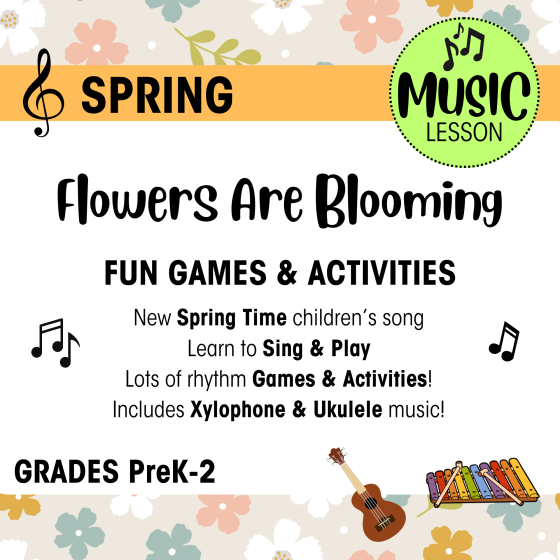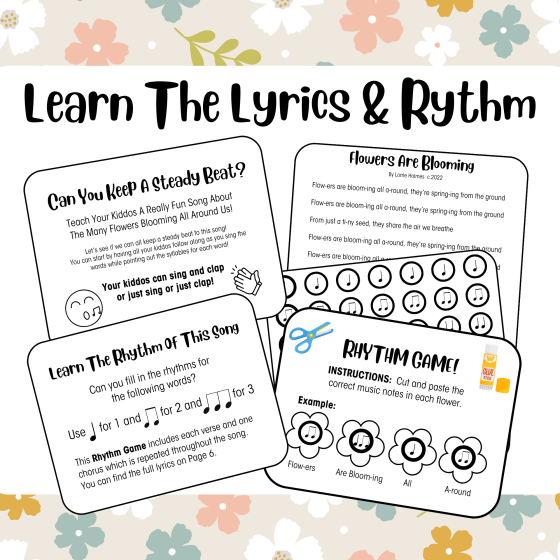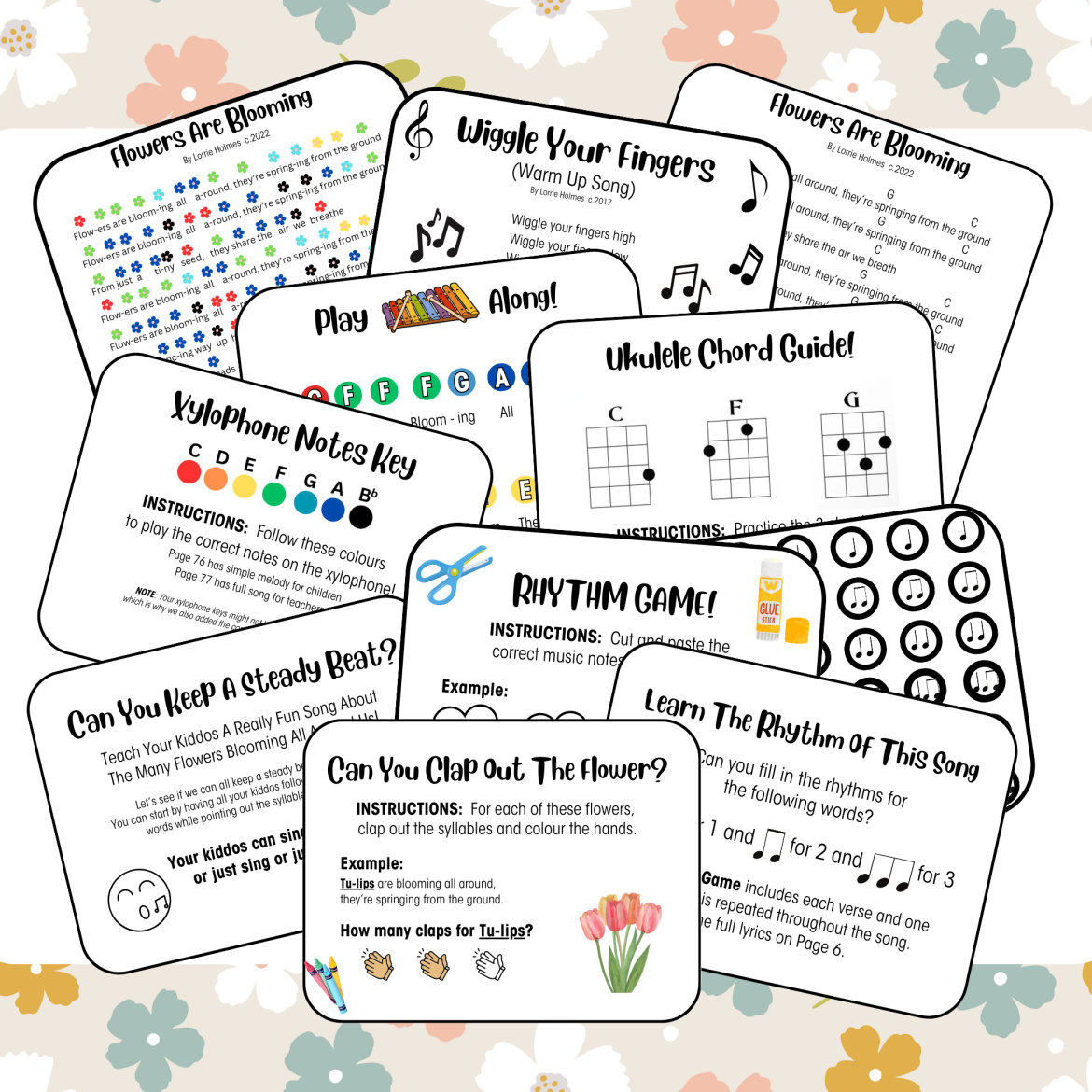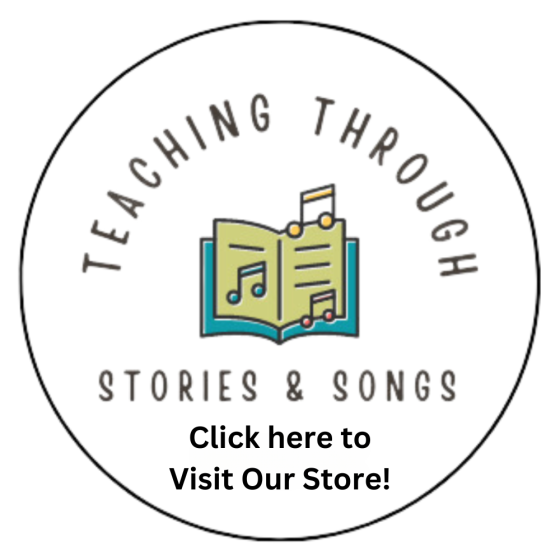by Lorrie Holmes
Children enjoy singing catchy spring songs that breathe life into this colourful season – especially those offering actions and visual prompts! Our fun Spring Music Lesson includes favourites focus on blooming flowers, insects, sunny weather, and outdoor activities.
From The Itsy Bitsy Spider to I’m a Little Teapot, Bringing Home A Baby Bumblebee to I Love Bugs, The Ants Go Marching and of course, the infamous The Garden Song by Charlotte Diamond, each of these sing songs tell a fun story that include lyrics that can easily be acted out by the children, resulting in a deeper level of understanding in and appreciation for springtime – the season of new beginnings.
As an early childhood educator and early learning music teacher, I have been blessed to lead music in many of the programs I have worked in – including my past weekly music lessons in childcare centres such as CEFA South Delta and Global West Montessori where I also incorporated music into my Circle Times.
Today, I am so excited to be sharing with you a spring song and music lesson that I created for my own students a few years back that they immediately took to. This cheerful melody and its playful lyrics help keep young children engaged, and learning about spring flowers in bloom as a fun experience. This package is one that can be used by any teacher – with kids from PreK to Grade 2, as the lessons are progressive. They start with learning the lyrics and rhythm in a fun game-based way, to breaking down the syllables, identifying music notation, and even playing and/or singing along to this fun little tune on both the xylophone and ukulele!
SPRINGTIME MUSIC SALE!
The Flowers Are Blooming Music Lesson is now available to download at our new Teachers Pay Teachers Store!

This lesson includes sheet music for both the xylophone and ukulele. The xylophone keys have been colour coded with corresponding notes indicated, and are easy for any teacher to play – and even for your more advanced students to be able to follow along as well – even if just hand-over-hand!
The interactive nature of this music lesson ensures that children remain actively engaged and motivated throughout the learning process. Overall, this spring-themed lesson provides a harmonious blend of music and language learning, in a fun and interactive format.
Within this Music Package, children will learn
- THE LYRICS TO THE FLOWERS ARE BLOOMING SONG
- THE RHYTHM OF THIS SONG THROUGH FUN GAMES & ACTIVITIES
- HOW TO IDENTIFY THE SYLLABLES TO POPULAR SPRING FLOWERS IN BLOOM
- TO SORT & MATCH UP POPULAR SPRING FLOWERS IN BLOOM
- TO SING ALONG TO THE XYLOPHONE NOTES TO THIS SONG
- TO ATTEMPT TO PLAY THIS SIMPLE MELODY ON XYLOPHONE
- TO SING ALONG TO THE UKULELE CHORDS


1. LEARNING THE LYRICS
When introducing new song lyrics to younger children, I usually start by singing it through the first time and then reading the lyrics line by line, and then singing it to them in the same order. The Flowers Are Blooming song lyrics read like couplets so I would read two rhyming lines at a time and have the children repeat them back to me. Then I would sing the lines to them and have them sing them back to me. Writing out the lyrics on a white board or large format lined paper is also very helpful for pointing to and following along and are a great way to get started. You can also add the AABB and ABAB rhyme schemes if this works as an age appropriate progression for your kids.
2. LEARNING THE RHYTHM
In my experience, the easiest way to teach the rhythm of this song to young children is to break it down into these 4 steps. This progression will take time to practice with the children and you can start off with reading and clapping the first week and then moving onto singing and clapping the second week, and so forth.
Here are the steps I would take for this activity.
a. I read the song as I clap out each line and have the children follow along.
b. I now advance to singing and clapping as the children follow along.
c. I sing as the children clap along.
d. I clap as the children sing by themselves.
3. IDENTIFYING THE SYLLABLES
Learning about syllables is such a popular way to teach children rhythm at this age and clapping out and identifying the syllables really helps with phrasing how to sing this song. After the children get used to clapping out the song and singing it at the same time, you can start to have fun challenging them to identify how many syllables each word has in the song. This learning can be reinforced with our various activities in this lesson – from colouring in the number of claps to cutting and pasting the simple music notation.
4. SINGING ALONG TO THE XYLOPHONE NOTES
This is always such an exciting experience for the children. Firstly, they love the colourful xylophone keys and most children seem to be really fascinated by the sounds that are produced when my pink mallet hits these colourful keys! You can always start with one of their favourite songs that they are used to singing along to – such as Twinkle Twinkle Little Star – and then next, you can introduce the new song you are teaching them, such as Flowers Are Blooming. This way, the kids are reoriented to the activity of singing along to the xylophone and they will relax faster and be able to focus on the task at hand.
5. PLAYING THE XYLOPHONE NOTES
When playing the xylophone notes, I often have the magnetic notes displayed line by line on my music staff so children can see the coloured notes and hit the proper keys as they associate the matching colour to the key. We can practice this step by step, and hand over hand, if needed, and I always ask the child first if they would like to try this. Most say yes, and I’m totally fine with those who would prefer to just watch and take this all in. These children will sometimes approach me afterwards when there is not an audience and ask to practice with me during free play as I often set out the xylophone music card with the instrument as a table top activity on music day.
I would recommend picking up a xylophone that has the removable keys so you can add the sharps and flats and even take out any keys that are not being played in the song you are working on.
6. SINGING ALONG TO THE UKULELE
This is such a fun exercise for the children! They just love the sound of the ukulele. When I introduce a new song to them, of course, I start with a warm up song they are used to to singing with the ukulele.



